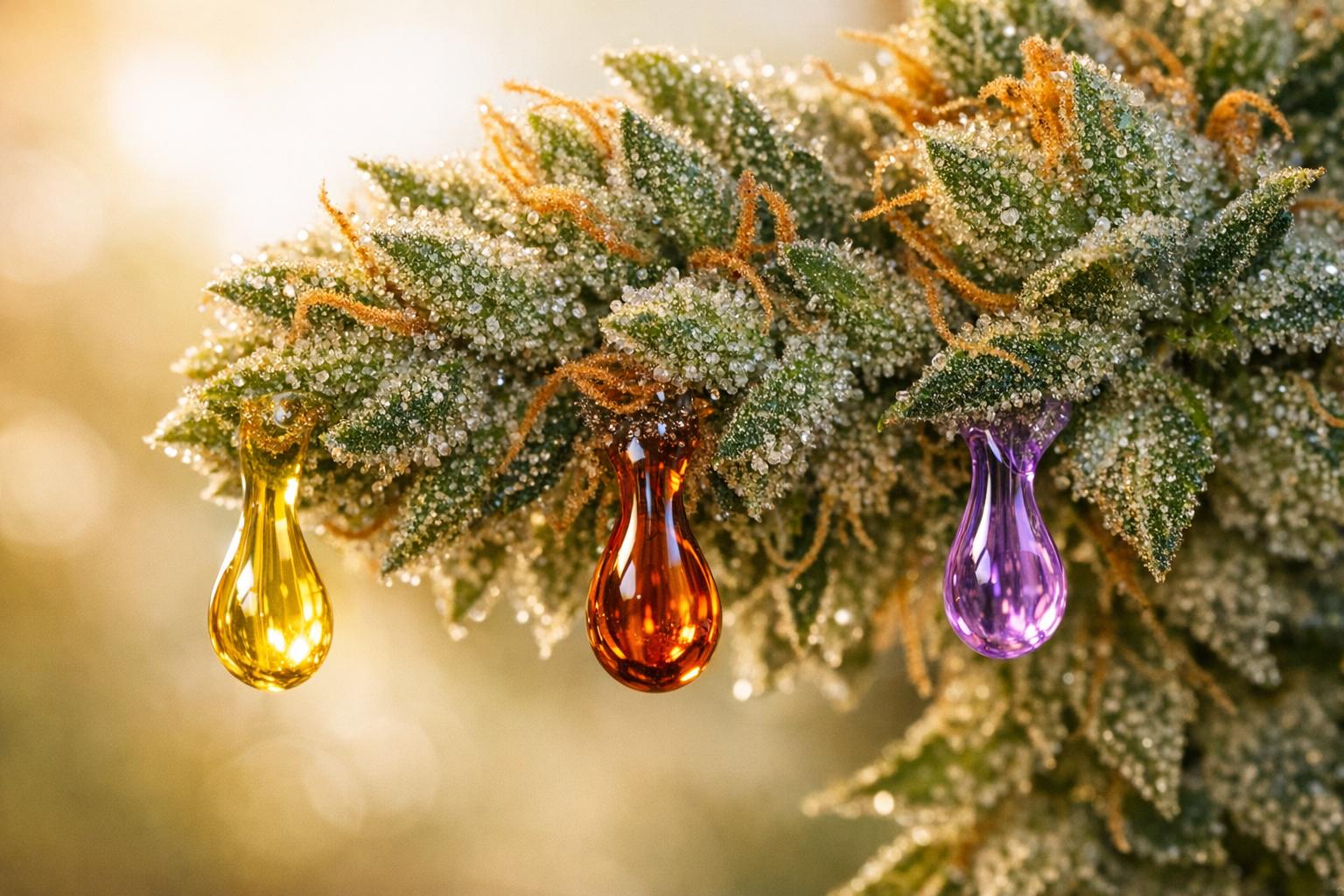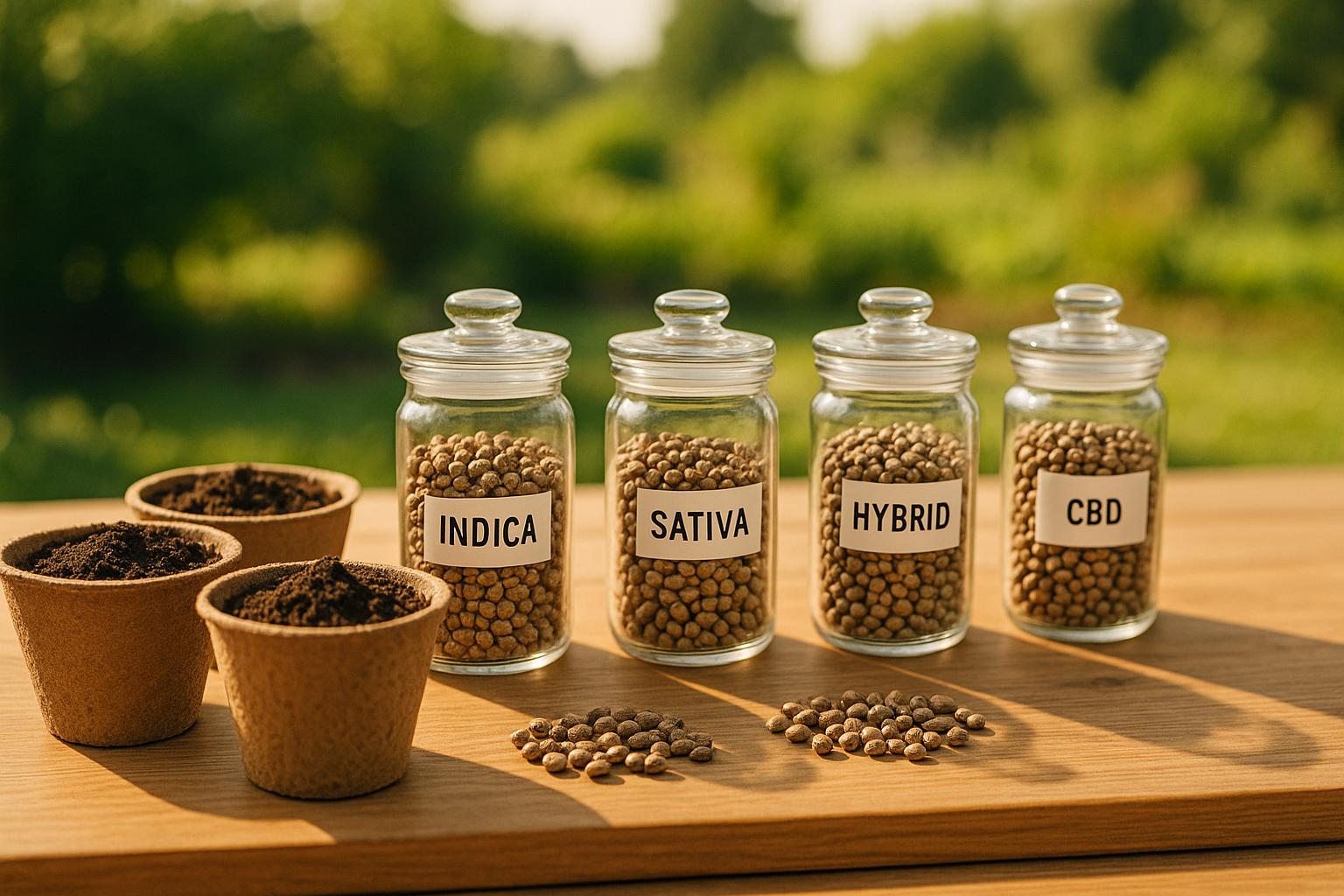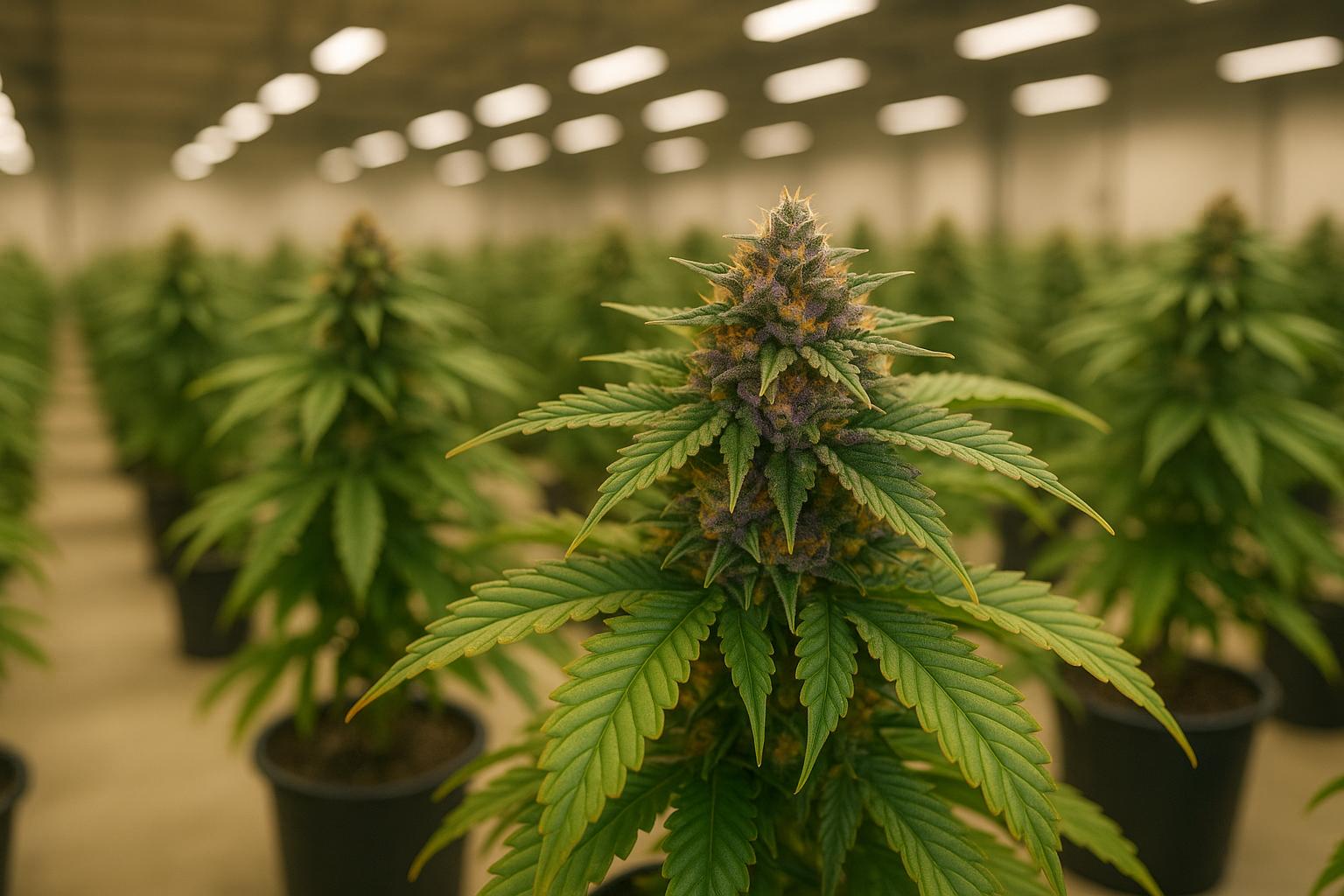Choosing between feminized and regular cannabis seeds is a key decision for growers. Feminized seeds guarantee nearly all-female plants, ideal for maximizing bud production. On the other hand, regular seeds produce both male and female plants, preserving genetic variety and making them better for breeding. Your choice depends on your goals — whether you want higher yields or more flexibility for creating new strains.
Quick Overview:
- Feminized Seeds: ~99% female plants, efficient for bud-focused grows, less genetic diversity.
- Regular Seeds: ~50/50 male-to-female ratio, essential for breeding, more genetic variety, but requires more effort.
Quick Comparison:
| Aspect | Feminized Seeds | Regular Seeds |
|---|---|---|
| Female Plant Rate | ~99% | ~50% |
| Labor Needed | Minimal | High (remove males) |
| Breeding Potential | Limited | High |
| Yield Efficiency | High | Lower (due to males) |
| Genetic Diversity | Low | High |
Feminized seeds are perfect for growers prioritizing simplicity and yield, while regular seeds are better for breeders and those exploring genetic possibilities.
1. Feminized Seeds
Genetic Composition
Feminized seeds take the guesswork out of determining plant gender. These seeds are specifically designed to ensure that nearly all offspring are female. In cannabis, female plants carry two X chromosomes (XX), while male plants have one X and one Y chromosome (XY). To create feminized seeds, breeders use techniques like colloidal silver treatment to force a female plant to produce male flowers. The pollen from these male flowers lacks a Y chromosome, resulting in seeds with an almost exclusive XX configuration. This careful genetic manipulation ensures that the majority of plants grown from these seeds will be female, setting the stage for higher efficiency and yield.
Yield Potential
Feminized seeds are a game-changer for cultivation because nearly every plant grown will produce buds. This means growers can make the most of their available space and resources, which is especially important in setups with limited room or strict plant count regulations. For commercial growers, this reliability translates into lower costs for water, nutrients, and labor while maximizing output.
Labor and Resource Requirements
Feminized seeds also simplify the growing process by removing the need to identify and eliminate male plants. This saves growers time and effort, allowing them to focus on fine-tuning growing conditions, improving training techniques, and perfecting harvest timing. Additionally, resources that would have gone to maintaining male plants can now be fully directed toward the female plants, leading to noticeable cost savings for both small-scale and large-scale growers.
Breeding Suitability
While feminized seeds are excellent for producing high yields, they aren't as ideal for breeding programs that require a wide genetic pool. The process of creating feminized seeds can limit genetic diversity, which might impact the natural vigor of the plants. However, they still have their place in smaller breeding projects or phenotype hunting, where the goal is to identify standout female plants for cloning or limited cross-breeding efforts.
2. Regular Seeds
Genetic Composition
Regular seeds are the result of traditional cross-pollination between male and female plants. Unlike feminized seeds — which are created by treating female plants with substances like colloidal silver or gibberellic acid to produce pollen and ensure nearly all-female offspring — regular seeds retain their natural genetic makeup. This means they produce both male and female plants in equal proportions, preserving their full genetic diversity. This natural balance is especially important for breeding programs, as it allows for the unaltered transfer of genetic traits.
"Regular seeds contain endless possibilities for growers to experiment with." - Sensi Seeds
Breeding Suitability
When it comes to breeding, regular seeds are indispensable. Both male and female plants are necessary to create new strains, and regular seeds provide the genetic stability needed to reliably pass desirable traits from one generation to the next. Their unmodified genetics also offer breeders the chance to explore diverse combinations, leading to the development of entirely new cannabis varieties that feminized seeds simply can't produce. Additionally, plants grown from regular seeds are known for producing strong, healthy clones, making them a valuable resource for propagation beyond seed production.
Labor and Resource Requirements
Growing regular seeds requires a hands-on approach. Since these seeds produce male and female plants in nearly equal numbers, growers must carefully monitor their crops during the early flowering stage to identify and remove male plants before they can pollinate the females. This process is time-intensive and demands attention to detail. Moreover, because male plants don't produce buds, resources spent on them - such as space, water, and nutrients - are essentially wasted if the goal is solely to harvest buds.
Yield Potential
The 50/50 gender ratio in regular seeds introduces unique challenges for yield. With half the plants being male and not contributing to the harvest, growers may see reduced efficiency compared to feminized seeds. However, regular seeds come with a hidden advantage: their genetic diversity often results in plants that are more resilient to environmental stresses, diseases, and pests. This robustness can lead to more consistent yields over time, even if the initial harvest might be smaller. For commercial growers aiming to maximize harvestable buds, regular seeds require a larger upfront investment in seeds, space, and resources to achieve the same number of productive female plants.
Feminized Seeds or Regular Seeds - Which is Better? And What's the Difference? (Instagram Question)
sbb-itb-1add288
Advantages and Disadvantages
Choosing the right type of seeds depends on your cultivation goals. Each seed type has its own set of benefits and challenges that can affect your growing experience and results.
| Aspect | Feminized Seeds | Regular Seeds |
|---|---|---|
| Female Plant Rate | ~99.9% female plants | ~50% female, 50% male |
| Labor Requirements | Minimal (no need to identify or remove males) | Higher (requires identifying and removing males) |
| Space Efficiency | Maximizes available space since every plant produces buds | Reduced efficiency due to roughly half the plants being male |
| Resource Utilization | Efficient use of nutrients and lighting for buds | Some resources go to non-budding male plants |
| Breeding Potential | Limited (nearly all plants are female) | Excellent (both sexes available for crossbreeding) |
| Genetic Diversity | Often derived from elite clones, leading to less variation | Provides natural genetic variability |
| Cost per Seed | Higher upfront investment | Lower initial cost |
| Risk Management | Very low risk of accidental pollination | Higher risk if male plants aren’t removed |
| Beginner Friendliness | Great for beginners seeking simplicity | Requires more experience and attention |
| Commercial Viability | Perfect for consistent flower production | Ideal for breeding and preserving genetics |
The table above highlights the key differences, but let’s break down these trade-offs in more detail.
Feminized seeds are a popular choice for growers focused on maximizing yield. Since nearly all plants are female, they produce buds, making them especially appealing for indoor growers with limited space. With feminized seeds, you can make the most of your lighting, nutrients, and time, resulting in reliable and predictable harvests. While they may cost more upfront, their consistent performance often justifies the investment.
However, feminized seeds come with a trade-off: reduced genetic diversity. These seeds are usually derived from elite clones, which can limit variability. On the other hand, regular seeds are ideal for breeders and those interested in developing new strains. Their mix of male and female plants provides the necessary ingredients for crossbreeding, allowing for the creation of diverse and resilient strains.
Regular seeds do require more effort. Growers need to monitor plants closely and remove males to prevent accidental pollination. While their initial cost is lower, achieving a good yield often means planting more seeds. That said, their natural genetic diversity can result in plants that are better equipped to handle environmental stresses, pests, and diseases.
Ultimately, the choice between feminized and regular seeds depends on whether your priority is maximizing production or exploring breeding opportunities. Each option has its strengths, so understanding these differences can help you make the best decision for your growing needs.
Conclusion
Understanding your seed type is key to achieving your cultivation goals. Feminized seeds are ideal for growers focused on maximizing bud production, as they produce nearly all female plants. On the other hand, regular seeds bring genetic variety, making them essential for breeding and developing new strains.
Your choice should align with your goals. If you're new to growing or primarily interested in harvesting buds, feminized seeds make the process easier by eliminating the need to identify and remove male plants. For seasoned growers and breeders, regular seeds provide the flexibility needed to create unique strains and preserve important genetics. Both beginners and experts have found success - whether by simplifying their harvests with feminized seeds or exploring new possibilities with regular seeds.
Consider your growing environment as well. Indoor growers often prefer feminized seeds for their efficiency, while outdoor cultivators might appreciate the hardiness and adaptability of regular seeds.
It’s important to note that feminized seeds aren’t inherently better - they’re simply tailored for bud-focused cultivation. Both feminized and regular seeds serve distinct purposes in modern cannabis growing.
To ensure success, purchase seeds from reputable seed banks and breeders like the ones listed on Cannabis Seeds Directory. High-quality seeds reduce the risk of issues like mislabeling, genetic problems, or hermaphroditism - pitfalls that can be especially challenging for beginners.
FAQs
Why are feminized seeds a great choice for beginner growers?
Feminized seeds are a great choice for beginners because they make growing cannabis much easier. These seeds are specifically designed to grow only female plants, which means you won’t have to worry about spotting and removing male plants. This saves you time, effort, and resources during the cultivation process.
They’re also perfect for smaller grow setups. By ensuring all your plants are focused on producing buds, feminized seeds help you make the most of your limited space while aiming for a higher yield. For first-time growers looking for a smooth and productive experience, feminized seeds are a smart and practical option.
What role do regular seeds play in maintaining genetic diversity in cannabis breeding?
Regular cannabis seeds play a crucial role in preserving genetic diversity within the cannabis world. These seeds naturally produce both male and female plants, resulting in a broad gene pool that enhances the resilience and adaptability of cannabis strains. This diversity is invaluable for breeders looking to create new hybrids or safeguard the distinct traits of classic strains.
Using regular seeds allows growers to tap into a wider range of characteristics like flavor profiles, potency levels, and growth habits. This makes them an essential resource for pushing boundaries and ensuring the long-term sustainability of cannabis cultivation.
How do I choose between feminized and regular cannabis seeds for my growing needs?
Feminized vs. Regular Cannabis Seeds: What to Know
Choosing between feminized and regular cannabis seeds comes down to your growing goals and experience level.
Feminized seeds are designed to produce only female plants, which means you won’t have to worry about spotting and removing male plants. This makes them a solid choice for growers who want to streamline the process and focus on achieving higher yields of bud-producing plants.
Regular seeds, however, are a bit different. These can produce both male and female plants, making them a favorite among breeders or anyone interested in creating their own seed stock. While they offer more genetic variety, they also require extra attention to identify and separate male plants during the growing process.
When deciding, think about your priorities: Are you looking for simplicity and efficiency, or do you value genetic diversity and breeding potential? Also, consider your budget and how much time you’re ready to invest in managing your plants.



